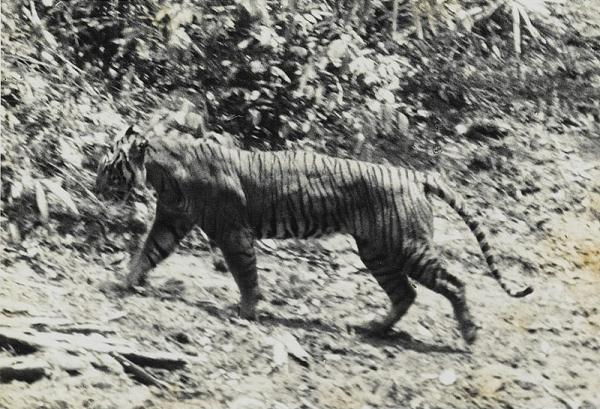
Iconic Cats: All 9 Subspecies of Tigers
Sumatran Tiger

Tigers are the largest members of the cat family (Felidae) and one of the most charismatic endangered species on the planet.
Over the last century, tiger numbers have fallen by about 95 percent and tigers now survive in 40 percent less of the area they occupied just a decade ago, according to the World Wildlife Fund (WWF).
Tigers have the species name Panthera tigris. There are nine subspecies of tigers, three of which are extinct.
A meeting set to begin in Russia on Sunday (Nov. 21) will examine some of the issues facing tigers in the wild and efforts to better conserve the six surviving tiger subspecies. Here we look at what sets each of these species apart.
Amur (or Siberian) tiger (Panthera tigris altaica)

Amur tigers (also known as Siberian, Manchurian, Ussurian, or Northeast China tigers) are the largest of the tiger subspecies. Males can grow up to more 10.5 feet (3.3 m) from head to tail and weigh up to 660 pounds (300 kilograms). Females are smaller, reaching just 8.5 feet (2.6 m) in length and about 200 to 370 pounds (100 to 167 kilograms) in weight.
Amur tigers have paler orange fur than the other tiger species and brown instead of black stripes. They have white chests and bellies and a white ruff of fur around their necks.
According to the National Fish and Wildlife Foundation's Save the Tiger Fund, wild Amur tigers are found in two main populations in in the Russian Far East, the primary population of about 450 individuals covers 60,000 square miles (156,000 sq km) in Primosky and Khabarovski Krais, and another small population of about 35 individuals occurs on the Russia-China border and into northeast China.
Officials representing China's Jilin province and Russia's Primorsky province, areas just north of the Korean peninsula, recently signed an agreement to set up a protected area straddling their countries' common border to safeguard the tiger, which is listed as Endangered on the International Union for the Conservation of Nature's Red List of Threatened Species.
Like many other threatened species, Amur tigers are being bred in zoos around the world to boost their populations and maintain healthy genetic stocks. Amur tiger triplets born in September recently made their public debut at the Pittsburgh Zoo. The Wildlife Conservation Society's Bronx Zoo also has a set of Amur tiger cubs.
Indian (or Bengal) tiger (Panthera tigris tigris)

The most numerous of the tiger species, the Bengal tiger is found in India, Bangladesh, Nepal and Bhutan. India is home to the largest population, estimated to between 2,500 and 3,750 individuals, according to the Save the Tigers Fund.
While most Bengal tigers have the coloration typically associated with their species, a recessive gene for coloration causes some to be cream or white in color instead of orange, according to the WWF. These "white" tigers are rarely found in the wild.
Wild tigers dwell in dry and wet deciduous forests, grassland and temperate forests and mangrove forests.
While this subspecies has more individuals left in the wild than its brethren, it is still listed as Endangered on the IUCN Red List.
South China tiger (Panthera tigris amoyensis)

Found in central and eastern China, the South China tiger is listed as Critically Endangered on the Red List one step higher than Endangered.
According to the WWF, the South China tiger is estimated to be functionally extinct. Currently 47 South China tigers live in 18 zoos, all in China, the WWF says.
Exact numbers of wild tigers, if there are any left, are unknown. Only 40 years ago there were reputed to be more than 4,000 tigers, but the government declared them pests, and they were hunted, according to the Save the Tigers Fund.
Field surveys conducted in 1987 and 1990 found evidence of a few tigers in the remote mountains of Guangdong, Hunan, and Fujian Provinces of South China, though no tigers were seen, Save the Tigers Fund says. The evidence came from anecdotal stories from hunters.
Malayan tiger (Panthera tigris jacksoni)

The Malayan tiger was only identified as being a separate subspecies from the Indochinese tiger in 2004. It is very similar to the Indochinese tiger, but is smaller in size.
Malayan tigers are found in the tropical and subtropical moist broadleaf forests of the southern tip of Thailand and Peninsular Malaysia.
The subspecies "jacksoni" was named to honor Peter Jackson, the former Chair of the IUCN Cat Specialist Group.
The IUCN lists the species as Endangered on its Red List.
Indo-Chinese tiger (Panthera tigris corbetti)

Also known as Corbett's tiger, after British hunter and naturalist Jim Corbett, this subspecies is found in Cambodia, Laos, Burma, Thailand, and Vietnam and formerly in China. They are listed as endangered on the IUCN Red List.
Indo-Chinese tigers are a bit smaller and darker than Bengal tigers, with shorter, narrower stripes. Males average 9 feet (3 m) from head to tail and weigh about 400 pounds (180 kilograms). Females are smaller, measuring about 8 feet (2.4 m) in length and weighing approximately 250 pounds (115 kilograms), according to the Save the Tigers Fund.
These tigers live in remote forests in hilly and mountainous terrain, which makes it difficult for scientists to gain access to their habitat. As a result, relatively little is known about the status of these tigers in the wild.
A 1998 assessment put the number of Indo-Chinese tigers in the wild at an estimated 736 to 1,225 individuals, according to the Save the Tigers Fund.
Genetic analyses in 2004 showed that Indo-Chinese tigers were a separate subspecies from Malayan tigers.
Sumatran tiger (Panthera tigris sumatrae)

Found only on the Indonesian island of Sumatra, the Sumatran tiger is listed as Critically Endangered on the Red List.
Sumatran tigers are protected by law in Indonesia, with tough provisions for jail time and steep fines, according to the WWF. But despite conservation and anti-poaching efforts, tigers are still hunted and tiger parts and skins remain in high demand.
The Sumatran tiger has the darkest coat of all tigers. Its broad, black stripes are closely spaced and often doubled. Unlike the Siberian tiger, it has striped forelegs.
Sumatran tigers are the smallest tiger subspecies. Males average 8 feet (2.4 meters) in length from head to tail and weigh about 260 pounds (120 kilograms). Females are closer to 7 feet (2 m) in length and weight about 200 pounds (90 kilograms).
The Indonesian Zoological Parks' Association (PKBSI) has been developing a conservation plan, and Sumatran tigers exist in Indonesia, North American, Australasian and European zoos. The San Diego Zoo Safari Park has two female Sumatran tiger cubs born in October.
Sign up for the Live Science daily newsletter now
Get the world’s most fascinating discoveries delivered straight to your inbox.
Bali tiger (Panthera tigris balica) - EXTINCT

One of the three extinct subspecies of tiger, the Bali tiger went extinct in the 1940's, according to the Save the Tigers Fund.
Tigers were last positively recorded in western Bali in the late 1930s, according to the IUCN.
The causes of extinction include hunting, loss of forest habitat and loss of their prey base. None of these tigers exist in captivity.
Javan tiger (Panthera tigris sondaica) - EXTINCT

This now-extinct species inhabited the Indonesian island of Java into the 1980's.
Tigers were last positively recorded from Java's Meru Betiri National Park in 1976, and likely disappeared from much of the rest of the island by the 1940s, according to the IUCN.
Caspian tiger (Panthera tigris virgata) - EXTINCT

The Caspian tiger (also called the Hyrcanian tiger or Turan tiger) became extinct in the 1970's.
Caspian Tigers and their large ungulate prey were found in the sparse forest habitats and riverine corridors west (Turkey) and south (Iran) of the Caspian Sea and west through Central Asia into the Takla Makan desert of Xinjiang, China, according to the IUCN.
Its extinction can be attributed to hunting of both tigers and their prey, habitat loss and conversion, and increased vulnerability of small populations.











